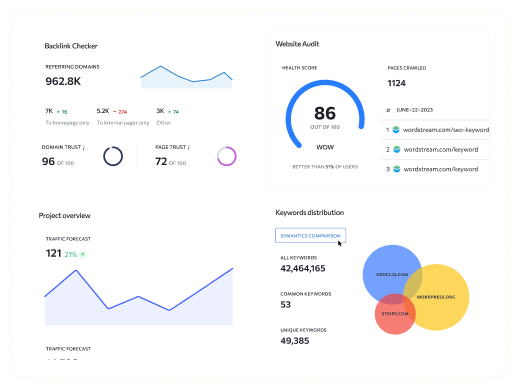Having an efficient ecommerce internal search system is crucial for boosting sales and enhancing user experience. Ecommerce internal search allows customers to quickly find the products they’re looking for, improving satisfaction and conversion rates. In this guide, we’ll explore the best practices for optimizing your ecommerce internal search to ensure it works effectively and efficiently.
In today’s competitive online marketplace, having a robust internal search function can be a significant differentiator. Customers who can easily find what they need are more likely to make a purchase and return for future shopping. This article covers everything from the basics of ecommerce internal search to advanced features, best practices, and real-world examples. By implementing these strategies, you can create a seamless shopping experience that meets your customers’ needs and drives your business forward.
What is Ecommerce Internal Search?
Ecommerce internal search refers to the search engine integrated into an ecommerce website, enabling users to find products, services, and information directly within the site. Unlike general search engines like Google, an internal search engine is tailored specifically to the website’s content and inventory.
Benefits of Ecommerce Internal Search:
- Improved User Experience: Users can find what they need quickly and efficiently, reducing frustration and increasing satisfaction.
- Increased Conversion Rates: Easier navigation leads to higher sales as customers find and purchase products more easily.
- Customer Retention: A seamless search experience encourages repeat visits, fostering loyalty and long-term customer relationships.
- Insight into Customer Behavior: Internal search analytics can reveal what customers are looking for, providing valuable data for optimizing product offerings and marketing strategies.
How Ecommerce Internal Search Works
An effective ecommerce internal search system involves several key components:
- Search Bar: The entry point for user queries. It should be prominently displayed and easy to access.
- Algorithms: Determine the relevance of search results based on various factors such as keywords, product popularity, and user behaviour.
- Result Pages: Display the products or information that match the search query, often including filters and sorting options to help users refine their search.
Advanced Features:
- Faceted Search: Allows users to filter search results based on attributes like price, brand, and category. This feature helps narrow down search results and makes it easier for users to find exactly what they need.
- Natural Language Processing (NLP): Helps interpret and return relevant results for complex queries by understanding the context and intent behind the search terms. This makes the search experience more intuitive and effective.
Importance of Ecommerce Internal Search for Online Stores
Ecommerce internal search online is a vital tool for any online store. Research shows that visitors who use the internal search function are more likely to convert than those who don’t. According to Econsultancy, visitors using the internal search are nearly twice as likely to make a purchase. This highlights the importance of investing in a robust internal search system.
Key Statistics:
- Higher Conversion Rates: Internal search users are 2-4 times more likely to convert compared to those who navigate the site manually.
- Enhanced User Experience: Facilitates easier navigation, leading to increased customer satisfaction and retention.
- Reduced Bounce Rates: Effective internal search can lower bounce rates by ensuring that users find relevant results quickly, keeping them engaged on the site.
Key Features of Effective Ecommerce Internal Search Solutions
To maximize the effectiveness of your internal search, consider integrating the following features:
- Faceted Search: Enables users to refine their search results using filters such as price, brand, size, colour, and other attributes. This helps users quickly narrow down options and find what they are looking for.
- Product Ranking and Relevance: Prioritize relevant products to appear first in the results. Use algorithms that take into account factors like popularity, user reviews, and seasonal trends to ensure the most relevant items are shown.
- Semantic Search and NLP: Understand the context and intent behind search queries to return the most relevant results. This involves breaking down the query into meaningful components and matching it with the appropriate products or information.
- Autocomplete and Error Correction: Suggest possible matches and correct typos as users type their queries. This helps users find what they are looking for even if they make spelling mistakes or are unsure of the exact product name.
- Synonym Handling: Ensure that different terms for the same product yield the same results. For example, a search for “sneakers” should return the same results as “running shoes.”
Types of Search Queries and Their Handling
Understanding the different types of search queries can help tailor your internal search engine to meet user needs:
- Exact Search Queries: Users know the specific product they are looking for and enter precise terms (e.g., “iPhone 13 Pro Max”). Ensure that these queries return exact matches quickly.
- Product Type Search Queries: Users search for a general product category rather than a specific item (e.g., “smartphones”). Your search engine should return a comprehensive list of products within the category, allowing users to filter and sort based on their preferences.
- Problem-based Search Queries: Users look for solutions to a problem (e.g., “How to fix a leaky faucet”). Provide relevant products along with helpful content such as guides or tutorials.
- Non-product Search Queries: Users seek information rather than products (e.g., “store hours” or “shipping policy”). Ensure your search engine can retrieve this type of information quickly and accurately.
Best Practices for Ecommerce Internal Search
To ensure your ecommerce internal search is optimized, follow these best practices:
- Make the Search Bar Highly Visible: Place it prominently on your website, preferably at the top of every page. Ensure it is easily recognizable and accessible.
- Provide Strong Autocomplete and Error Correction: Help users find what they’re looking for even with typos or incomplete queries. This improves user experience and increases the likelihood of conversion.
- Ensure the Search Never Ends with No Results: Always return relevant or related results. If no exact matches are found, suggest similar products or categories to keep users engaged.
- Optimize for Customer-Used Terms, Not Industry Jargon: Use language your customers use. Conduct keyword research to understand how your audience describes products and incorporate these terms into your search engine.
- Leverage Analytics Data for Continuous Improvement: Regularly review search data to identify trends and areas for improvement. Use eCommerce Internal Search Tracking to monitor performance and make data-driven adjustments.
- Provide Access to Non-Product Information: Include FAQs, guides, and support documents in search results to offer comprehensive information to users.
- Include Abundant Filtering Options: Allow users to refine their search results by various criteria such as price, brand, size, and colour. This makes it easier for users to find exactly what they need.
- Add Relevant Metadata to All Products: Ensure all items are accurately tagged with relevant keywords, descriptions, and attributes. This improves search accuracy and relevance.
- Optimize Mobile Search Functionality: Ensure search works seamlessly on mobile devices. Consider mobile-specific features such as touch-friendly filters and voice search.
- Use Visuals and Add-to-Cart Buttons in Search Results: Enhance user experience with product images and easy purchasing options directly from the search results page.
- Suggest Complementary Items and Upgrades: Recommend additional products based on search queries. This can increase average order value and improve customer satisfaction.
Implementing and Optimizing Your Ecommerce Internal Search
Steps to Choose the Right Internal Search Provider:
- Identify Your Needs: Determine what features and functionalities are essential for your business. Consider factors such as scalability, integration with your existing platform, and customization options.
- Research Providers: Look into different ecommerce internal search solutions. Evaluate their features, pricing, and customer reviews.
- Evaluate Based on Features and Cost: Consider the features offered and whether they fit within your budget. Look for providers that offer a free trial or demo to test their solutions.
Continuous Optimization Techniques:
- Use eCommerce Internal Search Metrics: Track key performance indicators such as search exit rates, conversion rates, and time spent on search results pages. Use this data to identify areas for improvement.
- Analyze Search Data Regularly: Use insights from search data to tweak and improve search performance. Look for patterns in user behaviour and adjust your search algorithms accordingly.
- A/B Testing: Test different configurations to see which yields the best results. Experiment with different search bar placements, autocomplete suggestions, and filtering options to optimize user experience.
Case Studies and Examples of Successful Ecommerce Internal Search Implementations
Example 1: Macy’s
- Success Factors: Macy’s has a highly visible search bar, extensive filtering options, and personalized suggestions. Their search engine uses advanced algorithms to prioritize relevant products and provide accurate results.
- Outcome: Significant increase in conversion rates and customer satisfaction. Macy’s internal search helps users find products quickly, leading to higher sales and repeat visits.
Example 2: Amazon
- Success Factors: Amazon’s search engine is known for its advanced NLP, autocomplete, and comprehensive search results. It can handle complex queries and provide highly relevant results.
- Outcome: Seamless user experience leading to higher sales and repeat customers. Amazon’s internal search is a key factor in its success as an ecommerce giant.
Conclusion
In conclusion, a well-optimized ecommerce internal search system is essential for improving user experience and increasing sales. By implementing the best practices and continuously optimizing your internal search functionality, you can create a seamless shopping experience that meets your customers’ needs and drives your business forward. Remember to leverage eCommerce Internal Search Tracking and eCommerce Internal Search Metrics to ensure ongoing improvements and success.
Note: Read Our Latest Marketing and SEO Blogs:
Exactly is AI in SEO | What is ai link building tool | What is voice ai seo | AI for On Page SEO | AI SEO for B2B | AI SEO for Fashion Brand | AI Competitor Analysis | Blog Post with AI | What is SEO Intelligence | AI SEO for WordPress | AI SEO Tips .
Frequently Asked Questions
Q1. What is an ecommerce internal search?
A1: Ecommerce internal search is a search engine integrated into an ecommerce website, enabling users to find products, services, and information directly within the site.
Q2. How can I improve my ecommerce internal search?
A2: Improve your ecommerce internal search by implementing features like faceted search, autocomplete, error correction, and NLP, and regularly optimizing based on search analytics data.
Q3. Why is internal search important for online stores?
A3: Internal search is important because it enhances user experience, increases conversion rates, and provides valuable insights into customer behaviour and preferences.
Q4. What are some best practices for ecommerce internal search?
A4: Best practices include making the search bar highly visible, providing strong autocomplete and error correction, ensuring the search never ends with no results, optimizing for customer-used terms, and leveraging analytics data for continuous improvement.
Q5. How does faceted search benefit users?
A5: Faceted search benefits users by allowing them to filter search results based on specific attributes like price, brand, size, and colour, making it easier to find exactly what they need.





